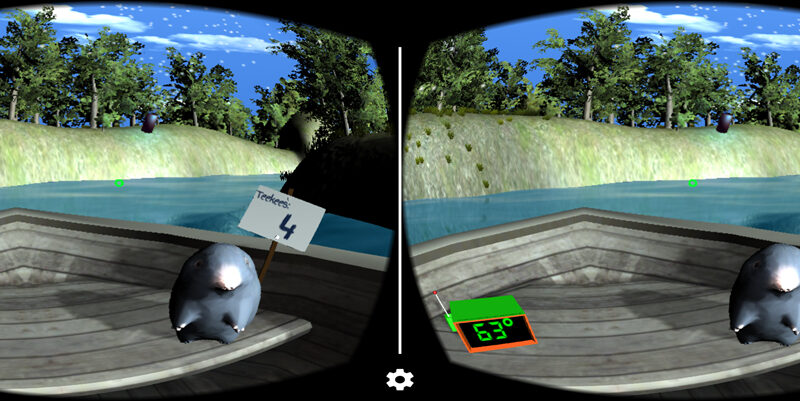Featured Researcher — Will Ray, PhD
Featured Researcher — Will Ray, PhD https://pediatricsnationwide.org/wp-content/themes/corpus/images/empty/thumbnail.jpg 150 150 Katie Brind'Amour, PhD, MS, CHES Katie Brind'Amour, PhD, MS, CHES https://pediatricsnationwide.org/wp-content/uploads/2021/03/Katie-B-portrait.gif- February 09, 2022
- Katie Brind'Amour, PhD, MS, CHES
William C. Ray, PhD, is a principal investigator in the Battelle Center for Mathematical Medicine in the Abigail Wexner Research Institute at Nationwide Children’s Hospital and an associate professor of Pediatrics at The Ohio State University. His work focuses on unique ways to explore, visualize and communicate data using his background in fine arts, molecular biophysics and computing.
“Holding Data in My Hand”
Dr. Ray and a student researcher combined digital time-lapse motion prediction with 3D printing technology to study molecular motion.
Read more. ›
One recent endeavor, published in October in the Journal of Burn Care & Research, started as an effort to create a handheld body scanner akin to the Star Trek tricorder to rapidly detect the percentage of skin affected by burns — and reduce medication errors caused by surface area misestimations. Instead, the team found simply redesigning the existing charts from the 1940s made estimating so easy that first responders and high school students alike can accurately assess the amount of the body that’s been burned (within 6%) in less than 2 minutes. Related treatment errors should drop significantly.
His next project will tackle robust visualization of anomalies in blood flow patterns to find out whether it can predict certain health problems, such as early onset cardiomyopathy, intrauterine growth restriction or preeclampsia.
Dr. Ray’s natural curiosity and broad skill set have resulted in unique and exciting collaborations with colleagues across Nationwide Children’s and beyond. Now, he begins yet another adventure focused on helping other researchers: building a scientific and medical graphics team to serve the hospital’s clinicians and scientists by creating more effective, appealing scientific and medical illustrations for publications and presentations. Reach out to him with any questions about collaborating, and be prepared for his passionate engagement with any project sent his way.
Read on to learn more about Dr. Ray and his work.
Why did you decide to pursue a career in your field?
I’m not sure I know what my field is. Whatever it is today will probably be different tomorrow.
A former student who is about to make a significant career change recently thanked me for giving her career advice when she was finishing her undergraduate degree. She was quite stressed at the time over the necessity to decide on a career and make all the big decisions that would set her on the course for the life she wanted. Apparently, I leaned back in my chair, stared at the ceiling and told her that I never had the slightest idea what I wanted to be when I grew up — and that I still didn’t. I told her to do what she loved and to keep doing it until she found someone who valued whatever it was that she was doing.
During a recent visit, she told me that what I had said back then was the best and most comforting advice anyone had ever given her. “If Dr. Ray doesn’t need to know what he wants to be when he grows up, then neither do I!” She’s been a microbiologist, artist and photographer and is now a lab manager. I don’t think she knows what she’s doing next (though I believe raising alpacas was on the list of possibilities) — and neither do I.
For as long as I can remember, I have been fascinated by learning new things and seeing things that have never been seen before. I was the kid who thought it was fascinating to turn over the logs in the woods, not to see the bugs, but because no one had ever seen the bottom of that particular log before. I’m still doing it. I turn over logs, look at the neat stuff, occasionally write a paper about it and somehow, I get paid for it!
These days, the “logs” look like macromolecular protein structure and function or like clinical challenges treating patients with burns. A lot of them involve turning data into pretty pictures. The only common theme is that these things fascinate me, and if I make nice tools to help me look at them, those tools often help others to pursue their science more effectively, too.
I’m not sure I know what my field is, and whatever it is today will probably be different tomorrow, but I’ll keep doing it until it doesn’t seem worthwhile, and then I’ll do something else. (Maybe I’ll raise alpacas!)
What was your path to your current role?
My career journey has been long and winding. I spent 17 years earning an undergraduate and two graduate degrees (in Math, Computer Science and Biophysics, respectively), and changed direction often along the way. For a while, I was a student of electrical engineering, physics and fine art. I almost got the fine art degree, but my focus turned towards a challenge in understanding the organization of Pyrococcus genomes, so I spent several years as a microbiologist.
I was recruited to Nationwide Children’s by a faculty member in the Center for Microbial Pathogenesis to work on microbial genomes as a postdoctoral researcher. I spent much of my time bugging Phil Johnson, MD, who was president of the research institute at the time, about how archaic the computing approaches being applied to biomedical data were.
I told him the hospital could leap to the forefront in so many areas if we had a core of computing experts to help our domain researchers. He told me to go make it happen.
Fun Facts About Dr. Ray
What do you usually eat for breakfast?
I haven’t had breakfast for years — coffee is as close as it gets.
What’s your favorite food?
I like absolutely anything other than okra. I can’t stand okra. It’s one of the few things I give myself the luxury of hating.
Favorite music?
There is very little that I don’t like musically, but I grew up in the 80s, and I think 80s music is still the right thing to listen to. We had the best decade.
Favorite thing you’ve bought this year?
I bought a bulldozer. It’s cool. We have some acreage in Hocking Hills. It’s probably 80% wooded and very hilly — it’s all ridges and valleys, and sometimes we need to push some dirt around for our projects. Whenever I get the chance, I use my bulldozer.
While my initial attempt at building a centralized computing support core didn’t pan out, the institution eventually formed the Battelle Center for Mathematical Medicine, where I landed as a faculty member. I still take Phil’s charge to “make it happen” as a mandate, though: I’m here to help people do their science better.
What is your favorite part of your job?
Teaching. While I quite enjoy teaching and mentoring trainees in the classroom or 1-on-1, I also see helping people learn more about their data as a form of teaching. The time I enjoy the most is the time I get to spend researching and developing new and better ways for people to learn from — or communicate about — their work, so they can help others learn more, too.
How does your research serve our patients and our community?
Much of my work involves helping others better serve our patients and community. Using what I know from biophysics, computation, electrical engineering, art and other fields, I’ve had the opportunity to help researchers at Nationwide Children’s and beyond. I’ve helped them better understand protein folding to understand the molecular mechanism of muscular dystrophy, built and printed 3D models to help surgeons plan how to separate a pair of conjoined twins and, most recently, helped our burn-trauma team develop a way to minimize errors in a critical step of burn treatment.
I’m particularly proud of that last one. Burn treatment involves estimating the percentage of a patient’s body affected by a burn. For a few decades it has been apparent that errors in these estimates are increasing, and there have been a number of attempts to identify a cause and to update the estimation tools to reduce errors. These efforts have been largely unsuccessful. Taking a computational approach, we studied the errors and discovered it was not the tool itself that was causing the errors: it was the math. We developed a new way to use the old tool so it no longer requires responders to calculate using a complex equation and mental math. With our new approach, responders just need to count, and the errors dramatically decrease.
The patent has been filed. We just held our first training session for first responders, and this is going to save people’s lives. It was a fascinating log to look under, and when I did, I found a way to help people help others better.
About the author
Katherine (Katie) Brind’Amour is a freelance medical and health science writer based in Pennsylvania. She has written about nearly every therapeutic area for patients, doctors and the general public. Dr. Brind’Amour specializes in health literacy and patient education. She completed her BS and MS degrees in Biology at Arizona State University and her PhD in Health Services Management and Policy at The Ohio State University. She is a Certified Health Education Specialist and is interested in health promotion via health programs and the communication of medical information.
-
Katie Brind'Amour, PhD, MS, CHEShttps://pediatricsnationwide.org/author/katie-brindamour-phd-ms-ches/April 27, 2014
-
Katie Brind'Amour, PhD, MS, CHEShttps://pediatricsnationwide.org/author/katie-brindamour-phd-ms-ches/April 27, 2014
-
Katie Brind'Amour, PhD, MS, CHEShttps://pediatricsnationwide.org/author/katie-brindamour-phd-ms-ches/April 27, 2014
-
Katie Brind'Amour, PhD, MS, CHEShttps://pediatricsnationwide.org/author/katie-brindamour-phd-ms-ches/April 28, 2014
- Posted In:
- Featured Researchers







